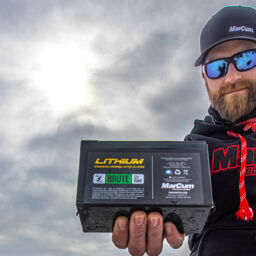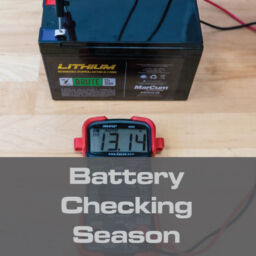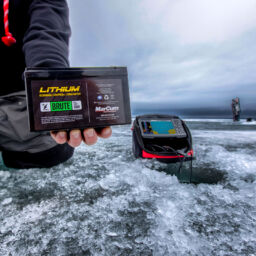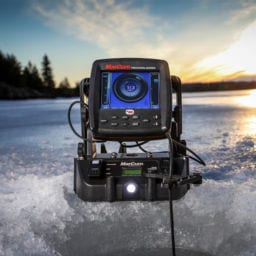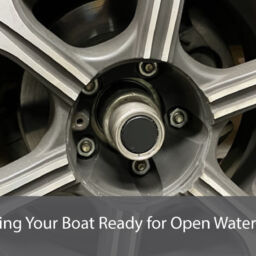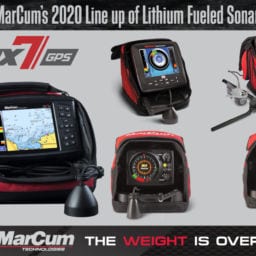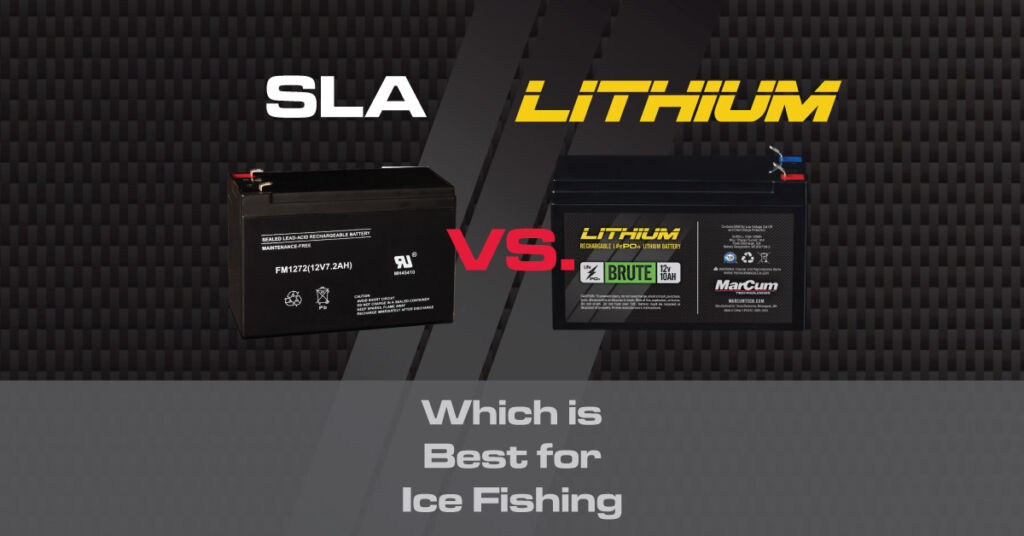
Lead-Acid vs Lithium: What Battery is Best for Ice Fishing?
No one can deny how much the sealed lead-acid (SLA) 12v battery has had an impact on ice fishing. This battery has been the dominant player in the game and has been used extensively for decades in flashers, digital units and camera systems throughout the ice belt. It allowed anglers to bring sonar technology into the sport and boy did they soak it up. The SLA was a pretty reliable power source but it was also a true heavyweight weighing 5 to 6 pounds for the standard battery.
With a standardized battery case size of 5.9 inches x 2.6 inches x 3.9 inches tall the amount of energy that could be packed into the 12 volt SLA was 7 to 9 amp-hours (Ah).
Amp-hours of course is a measure of the battery capacity and the higher the number the better. For example, the 12v 7Ah can supply 1A for 7 hours while the 8Ah can supply 1A for 8 hours. However, if you drain an SLA below 50% it will reduce the life of the battery. The total amount of energy that is discharged is referred to as depth of discharge. So in the case of a 12-volt 7Ah battery you really only have 3.5Ah of usable capacity. What does this mean? Well, the Marcum M1 uses 0.23A to operate so its run time with a 7Ah SLA is really only 15 hours if it was run continually.
But with this type of technology what is the battery life? Most sources indicate that the SLA will not last beyond 300 cycles. That means if you have charged your battery 250 times then you ought to start looking for a new one. Over time, SLA’s will lose capacity and are considered worn-out when they are below 70% nominal capacity. Generally speaking you should be able to get 2-4 years out of one.
SLA’s are proven so why change from a lead-acid to a lithium? There are many reasons why anglers and manufacturers are making the switch. The significant reduction in weight could be enough alone, but let’s take a closer look into the lead acid vs. lithium-ion comparison.
Which battery is best, a Li-ion or a lead acid?
Lithium is a light metal with great electrochemical properties. It is capable of generating sufficient voltage while occupying a small amount of space. Also a lithium based battery is capable of being charged and discharged at faster rates than lead-acid.
The first 12v lithium batteries to come on the market were lithium-ion. Lithium-ion has a much higher energy density than SLA’s which means they are much lighter. They also have a higher effective capacity or depth of discharge than SLA. As mentioned before, depth of discharge is simply the percentage of the battery that can be drained of energy without damaging it. And with lithium-ion it is possible to drain 85% of the capacity in a single use without causing damage.
Now let’s talk about weight. One lithium-ion product is lithium Mite that is a 12 volt 7.5Ah battery that weighs in at a scant 1.1 pounds. Remember the SLA weighs 5 to 6 pounds so you are talking about shedding some serious weight, like over 80%. Don’t let the feather weight scare you as that battery is made to do the work and then some. Being able to utilize the majority of the 7.5Ah means you are doubling the run time over SLA. It also can get you back out there quicker as a full charge only takes 3 – 5 hours. The typical estimated life of a lithium-Ion is about 4-5 years or around 300 charge cycles.
Most lithium-ion batteries encountered today in mobile devices, portable media players and laptops are technically a lithium-ion polymer battery. The Marcum lithium shuttle utilizes this type of battery for its 12 volt 12Ah powerhouse.
LiFePO4 Vs. Lead Acid
The latest and greatest lithium based battery on the market is the lithium iron phosphate (LFP, LiFePO4, LP4). LiFePO4 lithium cells are stout and one of the longest lasting battery chemistries available.
LiFePO4 batteries provide lower cost of ownership over SLA’s over the long term. The upfront cost is more but they will last much longer. LiFePO4 technology will provide close to 100% charge and discharge energy efficiency without causing damage. So no more worries about a long weekend of usage without being able to charge the battery because you won’t damage it.
LiFePO4 batteries are also light and strong. The Marcum lithium Brute is a 12 volt 10Ah battery that weighs in at a mere 2.7 pounds. And this 10Ah battery allows close to 100% discharge. That means that the aforementioned Marcum M3 can literally run for 50 hours straight. So this gives you over 50% reduction in weight over an SLA with almost 3 times the run time. That’s a textbook win-win scenario. And it actually gets even better.
Longevity is another big deal with the LiFePO4 as it can take over 2000 full charge cycles. Quick math suggests that this battery should last 7 times longer than the standard SLA. So it is going to help you catch more fish for a very long time.
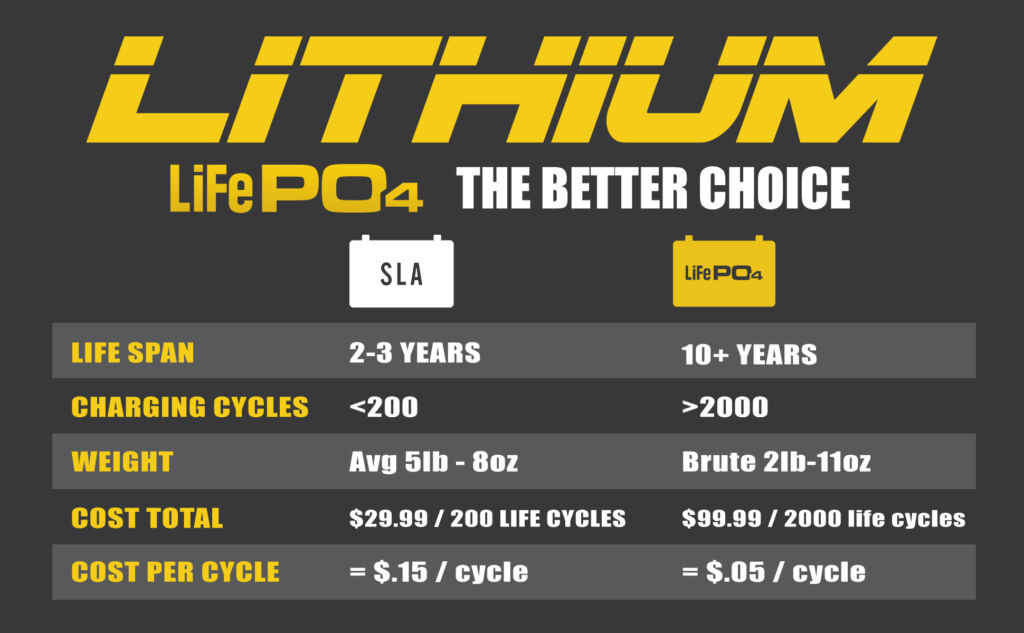
Marcum has a whole family of LiFePO4 batteries from the 10Ah Brute to the extreme 30Ah Max to serve any of your electronic needs. In fact, Marcum provides a table that lists the amp draw on all of the various electronics on the market. This allows you to approximate how much run time you can expect from a particular battery for your ice unit. Talk about slick, this is powerful information to help you make a good decision in your purchase.
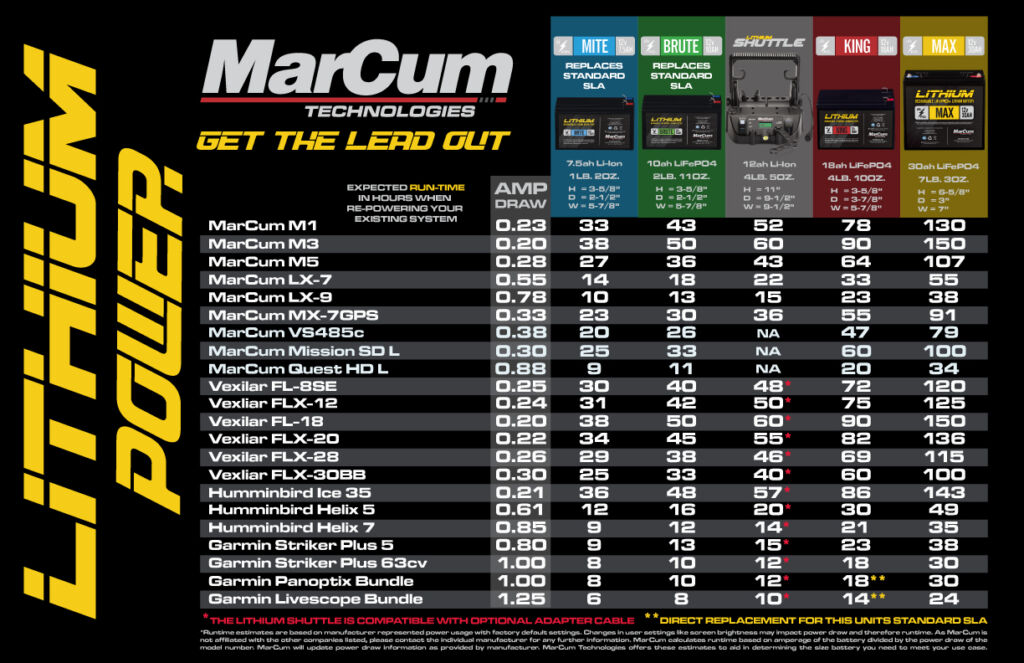
Suffice to say that lithium based batteries are here to stay. It’s now a breeze for even children to grab electronics such as the LX-7L and go hole-hopping to their heart’s content. Anything that can improve the experience in the outdoors is a great thing and lithium batteries are just that.




